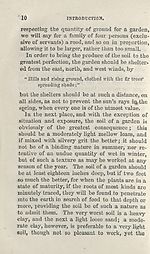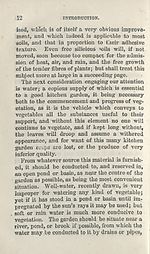Occupations > Abercrombie's improved practical gardener; with a monthly calendar for the flower garden
(15)
Download files
Complete book:
Individual page:
Thumbnail gallery: Grid view | List view

INTRODUCTION.
11
former may be made good garden soil with a
little trouble and expense, but the latter will
require a great deal of both. The circumstances
before mentioned having been considered, it
will very rarely happen that the soil should be
to the mind; it will either prove too poor, too
strong, or too light, and in either case it must be
carefully improved without delay; in the per¬
forming of which we must be guided by its
nature, so as if possible to render it subservient
^ to most general purposes. Hence our duty is to
endeavour to hit on that medium which suits
the generality of vegetables grown in kitchen
gardens.
If the bottom or subsoil be of a wet cankering
nature, judicious draining is the most eligible
means; but where the soil is stubborn, small
gravel, sand, coalashes, lime, brick-kiln-ashes,
&c. are very appropriate substances to be appli¬
ed, and will, if carefully and well worked into
the ground by digging in the winter months, or
indeed at all times when not in crop, soon bring
the ground into a proper texture for most pur¬
poses. The ground should be laid in ridges, in
order to give the greatest possible extent of
surface for the weather to act upon. Where the
soil is poor sand or gravel, clay, or clayey loam,
scourings of ditches which run on a clayey
subsoil, pond-mud from a similar situation, or
scrapings of roads which lie in a clayey district,
&c. are great improvers, but all these are of little
use unless the ground is well worked and pulver-
11
former may be made good garden soil with a
little trouble and expense, but the latter will
require a great deal of both. The circumstances
before mentioned having been considered, it
will very rarely happen that the soil should be
to the mind; it will either prove too poor, too
strong, or too light, and in either case it must be
carefully improved without delay; in the per¬
forming of which we must be guided by its
nature, so as if possible to render it subservient
^ to most general purposes. Hence our duty is to
endeavour to hit on that medium which suits
the generality of vegetables grown in kitchen
gardens.
If the bottom or subsoil be of a wet cankering
nature, judicious draining is the most eligible
means; but where the soil is stubborn, small
gravel, sand, coalashes, lime, brick-kiln-ashes,
&c. are very appropriate substances to be appli¬
ed, and will, if carefully and well worked into
the ground by digging in the winter months, or
indeed at all times when not in crop, soon bring
the ground into a proper texture for most pur¬
poses. The ground should be laid in ridges, in
order to give the greatest possible extent of
surface for the weather to act upon. Where the
soil is poor sand or gravel, clay, or clayey loam,
scourings of ditches which run on a clayey
subsoil, pond-mud from a similar situation, or
scrapings of roads which lie in a clayey district,
&c. are great improvers, but all these are of little
use unless the ground is well worked and pulver-
Set display mode to:
![]() Universal Viewer |
Universal Viewer | ![]() Mirador |
Large image | Transcription
Mirador |
Large image | Transcription
| Antiquarian books of Scotland > Occupations > Abercrombie's improved practical gardener; with a monthly calendar for the flower garden > (15) |
|---|
| Permanent URL | https://digital.nls.uk/121881399 |
|---|
| Description | Thousands of printed books from the Antiquarian Books of Scotland collection which dates from 1641 to the 1980s. The collection consists of 14,800 books which were published in Scotland or have a Scottish connection, e.g. through the author, printer or owner. Subjects covered include sport, education, diseases, adventure, occupations, Jacobites, politics and religion. Among the 29 languages represented are English, Gaelic, Italian, French, Russian and Swedish. |
|---|

